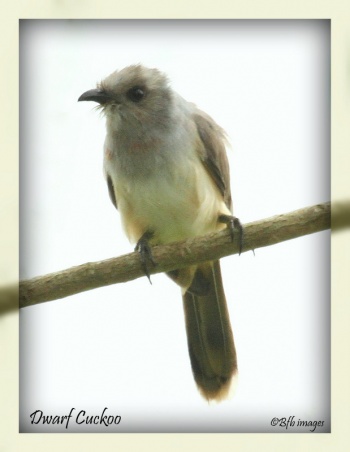m |
(Picture of Juvenile. Habitat expanded. References updated. Additional GSearch to cover both scientific names) |
||
| Line 1: | Line 1: | ||
| − | [[Image:6036Dwarf-Cuckoo-2_by_Robert_Scanlon.jpg|thumb| | + | [[Image:6036Dwarf-Cuckoo-2_by_Robert_Scanlon.jpg|thumb|400px|right|Photo by {{user|Robert_Scanlon|Robert_Scanlon}}<br />Sonso, near Cali, [[Colombia]], March 2006]] |
| − | ;[[: Category:Coccycua|Coccycua]] pumila | + | ;[[: Category:Coccycua|Coccycua]] pumila<br /> |
| + | ''Coccyzus pumilus'' | ||
==Identification== | ==Identification== | ||
Brown upperparts, face, throat and upper breast rufous, belly and undertail pale cream, underside of tail feathers medium brown with black subterminal and pale terminal bands. Notice the lack of a black bandits mask in face. Eye is red, bill dark, and legs dark. | Brown upperparts, face, throat and upper breast rufous, belly and undertail pale cream, underside of tail feathers medium brown with black subterminal and pale terminal bands. Notice the lack of a black bandits mask in face. Eye is red, bill dark, and legs dark. | ||
| Line 6: | Line 7: | ||
Northern [[Colombia]], and northern and central [[Venezuela]]. Vagrant in [[Panama]] and [[Brazil]]. | Northern [[Colombia]], and northern and central [[Venezuela]]. Vagrant in [[Panama]] and [[Brazil]]. | ||
==Taxonomy== | ==Taxonomy== | ||
| − | + | This is a [[Dictionary_M-S#M|monotypic]] species<sup>[[#References|[1]]]</sup>. | |
It has in the past been placed in genus ''[[:Category:Micrococcyx|Micrococcyx]]'' or in ''[[:Category:Coccyzus|Coccyzus]]''. | It has in the past been placed in genus ''[[:Category:Micrococcyx|Micrococcyx]]'' or in ''[[:Category:Coccyzus|Coccyzus]]''. | ||
==Habitat== | ==Habitat== | ||
| − | Gallery forest, more open areas with some trees or scrub. Increasing in areas with deforestation. | + | [[Image:848-003.JPG|thumb|350px|right|Juvenile<br />Photo by {{user|Bananafishbones|Bananafishbones}}<br />San Pablo Marshes, [[Venezuela]], March 2012]] |
| + | Gallery forest, more open areas with some trees or scrub. Increasing in areas with deforestation. Marshland and agricultural areas. | ||
==Behaviour== | ==Behaviour== | ||
Usually solitary. | Usually solitary. | ||
==References== | ==References== | ||
| − | # | + | #{{Ref-Clements6thAug11}}#[http://www.museum.lsu.edu/~remsen/SACCprop229.html SACC] proposal to use genus ''Coccycua'' for this species |
| − | #[http://www.museum.lsu.edu/~remsen/SACCprop229.html SACC] proposal to use genus ''Coccycua'' for this species | ||
# Restall et al. 2006. Birds of Northern South America. Yale University Press. ISBN 9780300124156 | # Restall et al. 2006. Birds of Northern South America. Yale University Press. ISBN 9780300124156 | ||
# Ridgely & Gwynne 1989. Birds of Panama. Princeton Paperbacks. ISBN 0691025126 | # Ridgely & Gwynne 1989. Birds of Panama. Princeton Paperbacks. ISBN 0691025126 | ||
| + | #Wikipedia | ||
| + | #BF Member observations | ||
{{ref}} | {{ref}} | ||
| − | |||
==External Links== | ==External Links== | ||
{{GSearch|Coccycua+pumil}} | {{GSearch|Coccycua+pumil}} | ||
| + | {{GSearch|Coccyzus+pumilus Use ''Coccyzus pumilus'' to}} | ||
| + | |||
[[Category:Birds]][[Category:Coccycua]] | [[Category:Birds]][[Category:Coccycua]] | ||
Revision as of 20:52, 15 April 2012
- Coccycua pumila
Coccyzus pumilus
Identification
Brown upperparts, face, throat and upper breast rufous, belly and undertail pale cream, underside of tail feathers medium brown with black subterminal and pale terminal bands. Notice the lack of a black bandits mask in face. Eye is red, bill dark, and legs dark.
Distribution
Northern Colombia, and northern and central Venezuela. Vagrant in Panama and Brazil.
Taxonomy
This is a monotypic species[1].
It has in the past been placed in genus Micrococcyx or in Coccyzus.
Habitat
Gallery forest, more open areas with some trees or scrub. Increasing in areas with deforestation. Marshland and agricultural areas.
Behaviour
Usually solitary.
References
- Clements, JF. 2011. The Clements Checklist of Birds of the World. 6th ed., with updates to August 2011. Ithaca: Cornell Univ. Press. ISBN 978-0801445019. Spreadsheet available at http://www.birds.cornell.edu/clementschecklist/downloadable-clements-checklist
- SACC proposal to use genus Coccycua for this species
- Restall et al. 2006. Birds of Northern South America. Yale University Press. ISBN 9780300124156
- Ridgely & Gwynne 1989. Birds of Panama. Princeton Paperbacks. ISBN 0691025126
- Wikipedia
- BF Member observations
Recommended Citation
- BirdForum Opus contributors. (2024) Dwarf Cuckoo. In: BirdForum, the forum for wild birds and birding. Retrieved 27 April 2024 from https://www.birdforum.net/opus/Dwarf_Cuckoo





